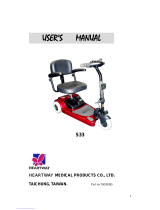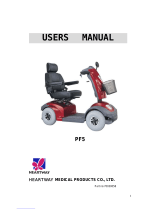
Eris
2020-01
Page 10
Other home devices like CD player, notebook, cordless phones, AM/FM radios, electric shavers and
hair dryers, so far as we know, will have no influence provided that they function perfectly and their
cabling be in an excellent condition. Please conform to the operating instructions accompanying such
electric instruments to ensure trouble free operating of your scooter.
1. Do not operate hand-held (transceivers-receivers), such as citizens band (CB) radios, or turn ON
personal communication devices, such as cellular phones, while the powered vehicle is turned ON;
2. Be aware of nearby transmitters, such as radio or TV stations, and try to avoid coming close to
them;
3. If unintended movement or brake release occurs, turn the vehicle OFF as soon as it is safe;
4. Be aware that adding accessories or components, or modifying the powered vehicle, may make it
more susceptible to EMI (Note: There is no easy way to evaluated their effect on the overall
immunity of the powered vehicle);
The intensity of the interfering EM energy can be measured in volts per meter (V/m). Each powered
vehicle can resist EMI up to a certain intensity. This is called its “immunity level”. The higher the
immunity level, the greater the protection. At this time, current technology is capable of achieving at
least a 20 V/m immunity level, which would provide useful protection from the more common sources
of radiated EMI. This powered vehicle model as shipped, with no further modification, has an
immunity level of 20 V/m without any accessories.
2.2 Carrying the scooter
The best way to carry the scooter is to make use of neutral mode of the scooter. Place the scooter in
neutral and roll the scooter to the desired place.
If this is not possible you can carry the scooter by following steps:
1. Switch the scooter off.
2. Remove loose parts (seat and batteries).
3. Store loose parts in a safe place.
4. Carry the frame + steering unit with 2 or 3 persons to the desired place. Take the frame on the
chassis, and not by the bumpers or the plastic parts. Only on the fixed parts from the frame.
2.3 Assembly and disassembly of the scooter
L WARNING: Risk of injury - Make sure that all movable parts are assembled properly.
L WARNING: Risk of injury - Assembly and disassembly must be done by trained
personnel (e.g. specialist dealer).
L WARNING: Risk of injury - Be careful not to cut or bruise yourself with the cables.
L WARNING: Risk of injury - Turn the scooter off before disassembly.
L CAUTION: Risk of pinching - Do not place fingers between the components of the
scooter.
To disassemble, please proceed as follows:
Switch the scooter off.
Remove the seat (see “Adjusting the seat” chapter).
Lift off the rear plastic cover of the batteries.
Loosen the straps used to fasten the
batteries in place.
Unplug all battery plugs (not the pole
connectors) and all cable plug- and socket
connections.
Lift the batteries out.
Fold the steering unit down.























